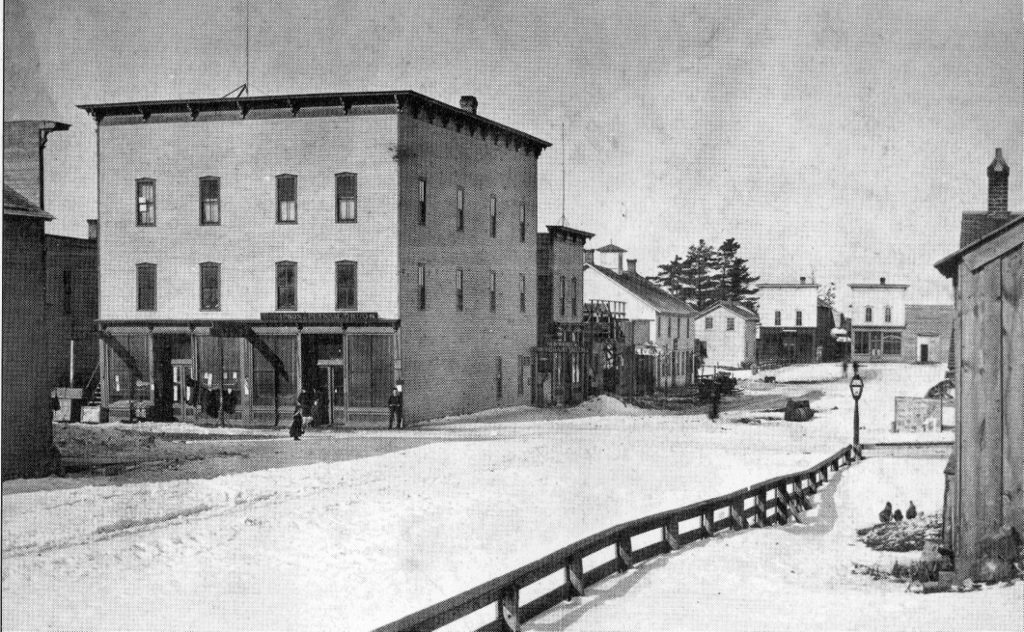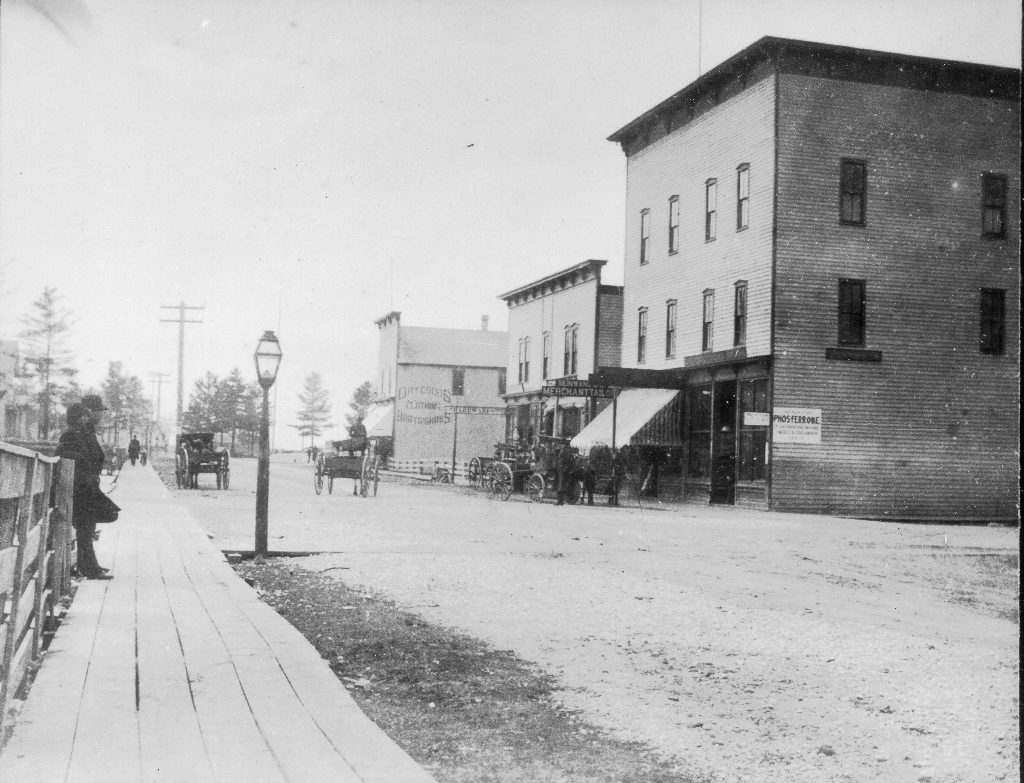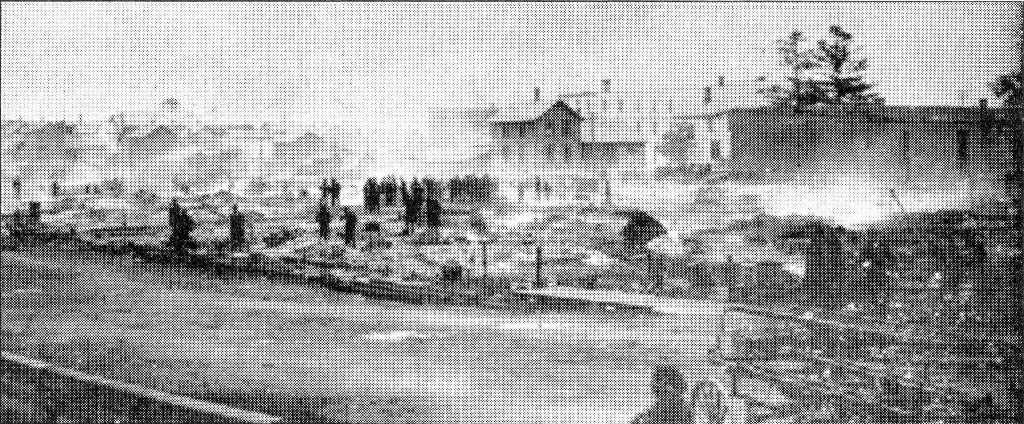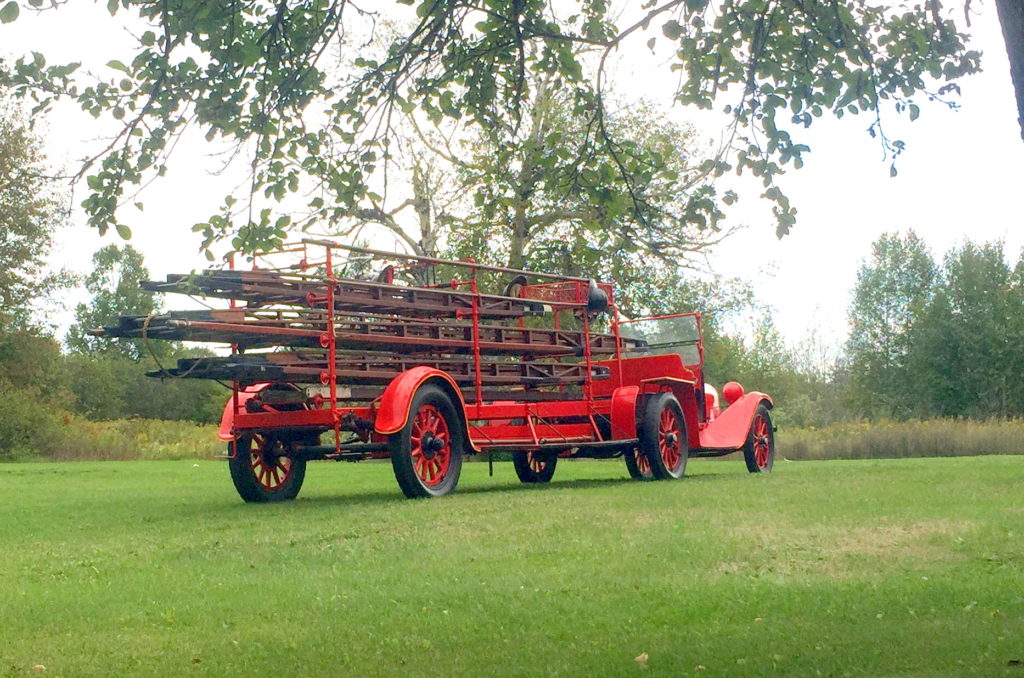
Pictured above is a circa 1890 photo of the corner of Cedar and Walnut Street in Manistique. The great fire of 1893 began in the rear of Paul Rediker’s Saloon on Walnut Street and quickly spread to adjacent buildings.
The great fire began at 11:15 in the evening on September 15, 1893. The undisputed cause of the fire was arson. Blue vaporous flames were seen leaping from the ground to the roof in the rear of the Alexander Richards building on Walnut Street. Splashing liberal amounts of either gasoline or coal oil against the side of the structure, the arsonist applied a match and disappeared into the shadows. The culprit was never brought to justice and his motive forever unknown.
Citizens spotted the flames almost immediately and turned in an alarm—but when the fire department arrived they confronted a raging inferno. All of the businesses and residences on Walnut Street were constructed with wood and were extremely dry. Gale force winds out of the northwest spread fiery embers to nearby buildings on Walnut Street and to businesses on Cedar Street. The Richards building, which was occupied by the Paul Rediker Saloon, was soon transformed into a pile of ashes. Occupants on the second floor of the building barely escaped alive. Other businesses on Walnut Street including saloons owned by Antowine Vassau and Fenton Gorman, along with the John Hackenbrach and Robert Knudson barbershops, the Bebeau Brothers livery and the John Kirstine tailor shop soon succumbed to the flames.
The Manistique fire fighters had no chance to halt the spread of the fire—though everyone praised their heroic efforts to do so. In 1893 the fire department consisted of two hand powered pumps, a hose cart and a horse drawn hook and ladder wagon. The water was brought to the scene by draymen hauling barrels of water from the Manistique River or from the few wells that existed. The editor of the Pioneer newspaper later lamented that “Manistique has the best men in the world to fight fire but they must have better facilities than hand engines and here and there a well of water.” The Manistique Tribune likened the city’s fire protection to that of a “squirt gun.”

Pictured above is an 1880’s view of Cedar Street. The McKinney building (far right) housed the Thompson and Putnam Drug Store, the Winkelman dry goods store and the Currie Jewelry Store on the first floor. Other buildings on Cedar Street included Costello’s grocery and Blumrosen’s brick building.
The fire raged unabated and soon spread to the buildings on Cedar Street. The McKinney building on the corner of Walnut and Cedar Street housed the Thompson and Putnam drug store, Winkelman’s dry goods, and the Currie Jewelry. The second floor was occupied by physicians Hafford and Bowen; and dentists Ellis and Johnson. The third floor hall was home to the Knights of Pythias and Good Templars lodges.
With the McKinney building in flames, the conflagration worked it way south on Cedar Street. The John Costello building was the next to be devoured, housing the Costello grocery store and the J. B. Lowis hardware on the first floor. The second story was occupied by the office of Thomas J. McMurray’s Manistique News and the apartment of Mr. LaFoyle and his mother.
Next door, the home of John Costello was soon transformed into a smoldering ruin and Blumrosen’s new brick dry goods store was the next business to be engulfed in flames. The fire caused the north wall of the building to collapse, but the south wall held, effectively stopping the spread of the fire southward. Moses Blumrosen suffered burns on his hands and face trying to save some of his stock.
Meanwhile, the fire jumped across Cedar Street spreading the devastation eastward. Orr Brothers & Co. meat market; E. F. Plunkett meat market; Lowis & Mills millinery; and the residence, barns and ice house of E. C. Brown were totally destroyed.
By 4:00 a.m. the fire was finally brought under control and allowed to burn itself out. Blumrosen’s brick building and an early morning rain were credited with preventing the spread of the fire toward the residential area on Lakeside. The roofs of many buildings a block or more away were set on fire by burning sparks carried on the wind, but were quickly extinguished by watchful citizens. The toll from the fire included 22 businesses destroyed and five families rendered homeless. Miraculously, there was no loss of life.

The devastation wrought by the fire is evident on the morning of September 16, 1893. Manistique’s hook and ladder wagon can be seen in the foreground while residents walk through the smoldering ruins.
There were many heroes. Harry Tucker emptied his livery stable, utilizing every horse and vehicle in an effort to haul property safely away. Bebeau Brother’s, after rescuing horses and harnesses from their barn also joined in the effort to save the property of others. Ben Jaffa was credited with saving a large quantity of the stock from the Winkelman store. Businesses not affected by the fire made space available to temporarily store property of others that had been rescued from the flames.
While many were helping to save property, there were others who were helping themselves to the loot. Both the Pioneer and the Manistique Tribune deplored the lawlessness. While praising the efforts of officers Jachor and Davidson to arrest the looters, the Tribune noted that “it would have required a score of special police to have captured one half of the lawbreakers.” The value of the losses from theft was estimated in the thousands of dollars. August Miller, a respected citizen, was erroneously arrested for starting the fire, but was later cleared of all suspicion and released. The guilty party was never found.
In the weeks following the fire there were calls for an improved system of water works and better fire suppression equipment to prevent the spread of future blazes. An ordinance was passed requiring that all future buildings be constructed with brick.

Pictured above is Manistique’s 1880’s hook and ladder wagon which responded to the fire of 1893. The horse drawn hook and ladder was married to a 1914 Dodge chemical truck by city workers in the fall of 1929. It also received a new chassis and rubber tires at that time.
